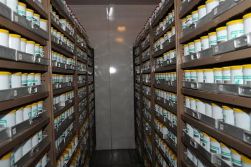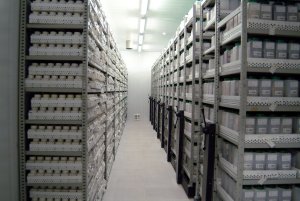Storage of cultivated chickpea and wild relatives genetic resources
Contributors to this page: ICRISAT, Patancheru, India (Hari D Upadhyaya, Shivali Sharma, Cholenahalli L Laxmipathi Gowda, Dintyala Sastry, Sube Singh); NBPGR, New Delhi, India (Shyam Sharma); ICARDA, Aleppo, Syria (Ahmed Amri, Kenneth Street, Natalya Rukhkyan), SARC-RIPP, Piestany, Slovak Republic (Gabriela Antalikova); Institute of Plant Genetic Resources ‘K.Malkov’, Sadovo, Bulgaria (Siyka Stoyanova); Department of Primary Industries, Victoria, Australia (Bob Redden); IPK, Gatersleben, Germany (Andreas Börner).
|
Contents: |
Base collection
|
|
| Long-term storage facility (photo: ICRISAT) |
A base collection is a long-term storage. The initial population is used as a bench mark for monitoring changes in genetic diversity over time and after several cycles of regeneration due to genetic drift. It should ensure that an accession’s seed viability remains at acceptable levels for at least 50 years, or at least one cycle of the regeneration of the accession.
When it should be used
- When aiming to store seeds for 50-100 years (Upadhyaya and Laxmipathi, 2009); FAO/IPGRI Standards, 1994).
-
Priority should be given to landraces, released varieties, wild relatives of crops and special genetic stocks.
- Landraces contain the greatest crop diversity with accessions adapted to a myriad of agro–ecological environments through long-term evolution in these localities.
- Breeding lines do not qualify as they are of short-term interest to breeders and continually displaced with each new breeding cycle.
- When needing to rejuvenate the medium-term collections, often after three multiplication cycles (so as to maintain genetic integrity of the original population).
Sample specifications
Minimum sample size for storage
A representative sample should be used to avoid genetic drift (Upadhyaya and Laxmipathi, 2009).
- For cultivated species: 1500-2000 seeds.
- For wild Cicer species: 300 seeds.
Minimum viability for storage
- Cultivated species: seeds with 90% or more viability.
- Wild Cicer species: seeds with 80% or more viability.
Moisture content
Important to avoid any deterioration pf the stored seed samples.
- 5-7% (FAO/IPGRI Standards, 1994).
Container specifications
Seed packaging method
Follow the procedures of the ICRISAT Genebank Manual (Upadhyaya and Laxmipathi, 2009).
- Prepare and label the aluminum foil packets with computer generated self-adhesive labels with the accession number, identity and season of harvest.
- Take out few samples at the time from the drying room to minimize re-absorption of moisture by the seed lot.
- Weigh the amount of seed prepared for storage and fill the container with seeds having at least 2.5 cm headspace for labelling.
- Place a non-adhesive label highlighting accession number, identity and season of harvest inside the packet.
- Seal the container using a standard vacuum sealer.
- Check for any deficiencies in packets and sealing.
- Print the date of sealing on the packet and move the samples to the long-term storage.
Specifications of packaging material
Follow the procedures of the ICRISAT Genebank Manual (Upadhyaya and Laxmipathi, 2009) and FAO/IPGRI Standards, 1994.
-
Use three layered standard aluminum foil packets consisting of the following layers:
- Polyester 17 g/m2 (an outer layer of 17 g Melinex and 4 g lacquer).
- Alufoil 33 g/m2 [a middle layer of 33 g (12 mm) aluminum foil and 4 g lacquer].
- Polyethylene 63 g/m2 (an inner layer of 63 g polyethylene).
- Use packets size of 190 x 160 mm for holding approximately 200 g of seed.
Storage specifications
Assigning location codes
Follow the procedures of the ICRISAT Genebank Manual (Upadhyaya and Laxmipathi, 2009).
- Use the exact location where the sample will be stored in the base collection (e.g. coded as 05-A-VI-06-132 indicating the room, rack, bay, shelf and tray numbers).
- Use computerized codes (for quick and easy retrieval of material).
- Use a barcode system (Genebank Information Management System, GIMS).
Storage conditions
- At -20ºC (FAO/IPGRI Standards, 1994).
Recording information during storage – Base collection
The following information should be recorded for each step:
- Accession identifier/number.
- Season of accession regeneration.
- Site of regeneration (location where germplasm was regenerated).
- Date of storage [long-term (LT) storage of sample (dd/mm/yyyy)].
- Location [location of the accession in the cold room (LT)].
- Seed quantity [weight of the seeds (g)].
- 100-seed weight (g) (100 randomly selected seeds).
- Type of container (for storing seeds - usually laminated aluminum foil for LT storage).
- Container number [number of seed containers for each accession (e.g. 1)].
- Seed moisture content (between 5-7% for LT storage).
- Germination % of the accession.
- Date of germination test (dd/mm/yyyy).
- Seed health status.
- Next recommended viability test date.
- Donor ID/Alternate ID/ Collector No. (collector’s name, donor name, any other alphanumeric character).
- Remarks (any other information).
For large genebanks with active, base and safe duplication strategies, the following alternative is recommended (ICARDA model):
- Weight of the sample.
- Number of seeds (estimated from weight using 1000 seeds).
- Number of packets.
- Year of production of seeds.
- Viability (%).
- Viability test date.
- Recommended next viability test date.
- Flag for regeneration (Y/N).
- Position of the sample in the storage.
Active collection
|
Active collection storage facility (photo: ICRISAT) |
|
Active collection at ICARDA (photo: ICARDA) |
An active collection consists of accessions that are available for distribution and are accessed frequently. The active collection is intended to preserve germplasm viability in a medium-term storage conditions for at least 20 years or for half of one regeneration cycle in the base collection.
When it should be used
- When aiming to store for 10-25 years (Upadhyaya and Laxmipathi, 2009 and FAO/IPGRI Standards, 1994).
- Used for immediate multiplication, distribution and use.
Sample specifications
Minimum sample size for storage
Follow the procedures of the ICRISAT Genebank Manual (Upadhyaya and Laxmipathi, 2009).
- Cultivated species: 400 g seeds.
- Wild Cicer species: 500 seeds.
Minimum viability for storage
Follow the procedures of the ICRISAT Genebank Manual (Upadhyaya and Laxmipathi, 2009).
- Cultivated species: seeds with 85% or more viability.
- Wild Cicer species: seeds with 80% or more viability.
Moisture content
To avoid any deterioration of the stored seed samples.
- 8-10% (Upadhyaya and Laxmipathi, 2009).
Container specifications
Seed packaging method
- Rust-proof aluminum cans with screw caps and rubber gaskets (Upadhyaya and Laxmipathi, 2009)).
Or
- Plastic containers (as used in ICARDA).
Specifications of packaging material
- Aluminum cans of 10 x 7.5 cm (Upadhyaya and Laxmipathi, 2009).
- Plastic containers 19.5 x 8.5 x 8.5 cm3 semi-transparent and withstanding low temperatures (as used in ICARDA).
Storage specifications
For easy access and location of the accessions.
Assigning location codes
- Use the exact location where the sample will be stored in the active collection (e.g. coded as 02-A-VI-06-15 indicating the room, rack, bay, shelf and tray numbers) (Upadhyaya and Laxmipathi, 2009).
- Use a barcode system (Genebank Information Management System, GIMS).
Storage conditions
- At +4ºC and 30% RH (Upadhyaya and Laxmipathi, 2009).
Recording information during storage – Active collection
The following information should be recorded for each step:
- Accession identifier/number.
- Season of accession regeneration).
- Site of regeneration (location where germplasm was regenerated).
- Date of storage [medium-term (MT) storage of sample (dd/mm/yyyy)].
- Location [location of the accession in the cold room (MT)].
- Seed quantity [weight of the seeds (g)].
- 100-seed weight (g) (100 randomly selected seeds).
- Type of container [container type for storing seeds (usually aluminum cans for MT storage).
- Container number [number of seed containers in each accession (e.g. 1)].
- Seed moisture content (between 8-10% for MT storage).
- Germination % of the accession).
- Date of germination test (dd/mm/yyyy).
- Seed health status.
- Next recommended viability test date.
- Donor ID/Alternate ID/ Collector No. (collector’s name, donor name, any other alphanumeric character).
- Number of times sampled for distribution (track distribution).
- Remarks (any other information).
For large genebanks with active, base and safe duplication strategies, the following alternative is recommended (ICARDA model):
- Weight of the sample.
- 1000-seed weight.
- Number of seeds (estimated from weight using 1000 seeds).
- Number of packets.
- Year of production of seeds.
- Viability (%).
- Viability test date.
- Next recommended viability test date.
- Flag for regeneration (Y/N).
- Position of the sample in the storage.
- Flag indicating distribution status (A, L, S).
For information on safety duplication, click here.
Storage management
Storage space arrangement
It is very important to provide easy access to the accessions.
If the genebank's main function is distibution of germplasm, then adopting a two-step storage system for maintaining active collections and base collections at controlled environments is recommended, otherwise a long-term storage condition should be adopted (Upadhyaya and Laxmipathi, 2009).
System for tracking material/inventory system
Samples must be quickly accessed.
- Develop a facility/database for tracking various operations including the inventory management for active, base and duplicate collections on Genebank Information Management System (GIMS):
-
- Passport details.
- Seed storage details.
- Sample location/position in cold rooms.
- Distribution of accessions (in the country and abroad).
- Storage should be arranged by crop and by accession number within the crop. Accession pouches should be labelled internally and externally with durable numbered and barcoded waterproof labels.
- Separate blocks of accession numbers with large margins should be assigned for each crop. This facilitates the correct retrieval of germplasm for distribution and for regeneration.
References and further reading
FAO/IPGRI. 1994. Genebank standards. Food and Agriculture Organization of the United Nations, Rome and International Plant Genetic Resources Institute, Rome. Available in English, Spanish, French and Arabic.
GIMS (Genebank Information Management System) – a standalone facility of ICRISAT Genebank. International Crops Research Institute for the Semi-Arid Tropics, Patancheru, A.P. 502 324, India. In: Manual of Genebank Operations and Procedures - Technical Manual no. 6. International Crops Research Institute for the Semi-Arid Tropics, Patancheru 502 324, Andhra Pradesh, India: ISBN 92-9066-421-5.
Stoyanova SD. 2001. Ex situ conservation in the Bulgarian genebank. I. Effect of storage. PGR-Newsletter 128:68-76.
Upadhyaya HD, Laxmipathi Gowda CL. 2009. Managing and Enhancing the Use of Germplasm – Strategies and Methodologies. Technical Manual no. 10. Patancheru 502 324, Andhra Pradesh, India: International Crops Research Institute for the Semi-Arid Tropics. 236 pp.
Comments
- No comments found








Leave your comments
Post comment as a guest